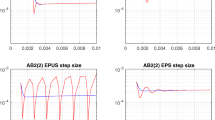Abstract
Adaptive time-stepping is central to the efficient solution of initial value problems in ODEs and DAEs. The error committed in the discretization method primarily depends on the time-step size h, which is varied along the solution in order to minimize the computational effort subject to a prescribed accuracy requirement. This paper reviews the recent advances in developing local adaptivity algorithms based on well established techniques from linear feedback control theory, which is introduced in a numerical context. Replacing earlier heuristics, this systematic approach results in a more consistent and robust performance. The dynamic behaviour of the discretization method together with the controller is analyzed. We also review some basic techniques for the coordination of nonlinear equation solvers with the primary stepsize controller in implicit time-stepping methods.
Similar content being viewed by others
References
K.J. Åström and B. Wittenmark, Computer Controlled Systems-Theory and Design, 2nd ed. (Prentice-Hall, Englewood Cliffs, NJ, 1990).
P. Deuflhard and F. Bornemann, Numerische Mathematik II: Integration gewöhnlicher Differentialgleichungen (Walter de Gruyter, Berlin, 1994).
C.W. Gear, Numerical Initial Value Problems in Ordinary Differential Equations (Prentice-Hall, Englewood Cliffs, NJ, 1971).
K. Gustafsson, M. Lundh and G. Söderlind, A PI stepsize control for the numerical solution of ordinary differential equations, BIT 28 (1988) 270–287.
K. Gustafsson, Control theoretic techniques for stepsize selection in explicit Runge-Kutta methods, ACM TOMS 17 (1991) 533–554.
K. Gustafsson, Control theoretic techniques for stepsize selection in implicit Runge-Kutta methods, ACM TOMS 20 (1994) 496–517.
K. Gustafsson and G. Söderlind, Control strategies for the iterative solution of nonlinear equations in ODE solvers, SIAM J. Sci. Comput. 18 (1997) 23–40.
E. Hairer, S.P. N¸rsett and G. Wanner, Solving Ordinary Differential Equations I: Nonstiff Problems, 2nd revised ed. (Springer, Berlin, 1993).
E. Hairer and G. Wanner, Solving Ordinary Differential Equations II: Stiff and Differential-Algebraic Problems, 2nd revised ed. (Springer, Berlin, 1996).
G. Hall, Equilibrium states of Runge-Kutta schemes, ACM TOMS 11 (1985) 289–301.
G. Hall, Equilibrium states of Runge-Kutta schemes, part II, ACM TOMS 12 (1986) 183–192.
G. Hall and D. Higham, Analysis of stepsize selection schemes for Runge-Kutta codes, IMA J. Num. Anal. 8 (1988) 305–310.
D. Higham and G. Hall, Embedded Runge-Kutta formulae with stable equilibrium states, J. Comput. Appl. Math. 29 (1990) 25–33.
H. Olsson and G. Söderlind, Stage value predictors and efficient Newton iterations in implicit Runge-Kutta methods, SIAM J. Sci. Comput. 20 (1999) 185–202.
H. Olsson and G. Söderlind, The approximate Runge-Kutta computational process, BIT 40 (2000) 351–373.
J.J.B. de Swart, Parallel software for implicit differential equations, Ph.D. thesis, CWI, Amsterdam (1997).
J.J.B. de Swart and G. Söderlind, On the construction of error estimators for implicit Runge-Kutta methods, J. Comput. Appl. Math. 86 (1997) 347–358.
T. Söderström and P. Stoica, System Identification (Prentice-Hall, Englewood Cliffs, NJ, 1989).
H.A. Watts, Step size control in ordinary differential equation solvers, Trans. Soc. Comput. Sim. 1 (1984) 15–25.
J.A. Zonneveld, Automatic numerical integration, Ph.D. thesis, Math. Centre Tracts 8, CWI, Amsterdam (1964).
Author information
Authors and Affiliations
Rights and permissions
About this article
Cite this article
Söderlind, G. Automatic Control and Adaptive Time-Stepping. Numerical Algorithms 31, 281–310 (2002). https://doi.org/10.1023/A:1021160023092
Issue Date:
DOI: https://doi.org/10.1023/A:1021160023092




